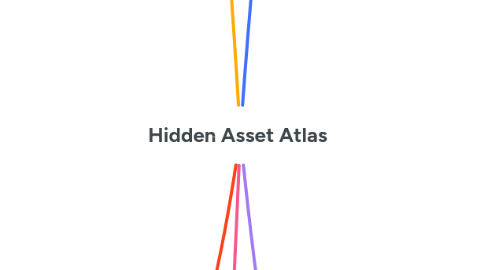
1. Under-Utilized Capacity
1.1. Equipment
1.1.1. Machinery and tools
1.1.2. Office equipment
1.1.3. Technology infrastructure
1.1.4. Vehicles
1.1.5. Unused licenses
1.2. Staff Time
1.2.1. Off-peak hours
1.2.2. Between-project availability
1.2.3. Specialized skills not fully utilized
1.2.4. Cross-functional capabilities
1.3. Distribution Channels
1.3.1. Physical locations
1.3.2. E-commerce platforms
1.3.3. Partner networks
1.3.4. International markets
1.3.5. Direct-to-consumer opportunities
1.4. Physical Space
1.4.1. Office space
1.4.2. Warehouse capacity
1.4.3. Retail frontage
1.4.4. Event space
1.4.5. Production facilities
1.4.6. Storage areas
2. Branding Authority
2.1. Recognition
2.1.1. Industry reputation
2.1.2. Media appearances
2.1.3. Speaking engagements
2.1.4. endorsements from influential figures or organizations
2.1.5. Case studies and testimonials
2.1.6. Awards
2.1.7. Certifications
2.1.8. Community Involvement
2.2. Digital Presence
2.2.1. Website authority
2.2.2. Search engine rankings
2.2.3. Social media influence
2.2.4. Online reviews
2.3. Pre-Eminent Positioning
2.3.1. Category ownership
2.3.2. Value
2.4. With Different Groups
2.4.1. Specific Customer Demographics
2.4.2. Within Industry Niches
2.5. Levels Of Engagement
2.5.1. Know
2.5.2. Like
2.5.3. Trust
2.6. Brand Expression
2.6.1. Colors
2.6.2. Name
2.6.3. Voice
2.6.4. Story
2.6.4.1. Historical Milestones
2.6.4.2. Traditions
2.6.4.3. Narrative
2.6.4.4. Origin Story
2.7. Miscellaneous
2.7.1. Quality guarantees
2.7.2. Transparency practices
2.7.3. Privacy commitments
2.7.4. Customer protect
3. Financial
3.1. Cash reserves
3.2. Credit lines
3.3. Investment portfolios
3.4. Grant eligibilities
3.5. Tax incentives
4. Relationships
4.1. Buyers
4.1.1. Prospects
4.1.1.1. Email lists
4.1.1.2. Social media followers
4.1.1.3. Website visitors
4.1.1.4. Event attendees
4.1.1.5. Webinar particiapnts
4.1.1.6. Types
4.1.2. Unconverted Leads
4.1.2.1. Applicants
4.1.2.2. Trials
4.1.2.3. Inquiries
4.1.2.4. Abandoned carts
4.1.2.5. Demo requests
4.1.2.6. Price quote requests
4.1.3. Customers
4.1.3.1. Employees Within Company
4.1.3.1.1. Champions
4.1.3.1.2. Recommenders
4.1.3.2. Types
4.1.3.2.1. One product vs multi-product
4.1.3.2.2. Past
4.1.3.2.3. Current
4.1.3.2.4. Dormant
4.1.3.3. Assets
4.2. Suppliers
4.2.1. Inventory
4.3. Vendors
4.3.1. Technology vendors
4.3.2. Service providers
4.3.3. Outsourcing partners
4.3.4. Freelancers and contractors
4.4. Partners
4.4.1. Affiliate marketers
4.4.2. Referral networks
4.4.3. Co-opetition
4.4.3.1. collaborating with competitors on non-core offerings or shared marketing efforts
4.4.4. Channel partners
4.4.5. Co-marketing partners
4.4.6. Strategic alliances
4.5. Industry Connections
4.5.1. Industry associations
4.5.2. Professional networks
4.5.3. Leadership positions
4.5.3.1. Community
4.5.3.2. Boards
4.6. Financial
4.6.1. Investors
4.6.2. Lenders
4.7. Employees
4.8. Retailers
5. Expertise
5.1. Propietary Data
5.1.1. Customer behavior insights
5.1.2. Market research
5.1.3. Competitive intelligence
5.1.4. Performance metrics (dashboard)
5.1.5. Historical trends
5.1.6. Predictive analytics
5.2. Systems
5.2.1. Customers
5.2.1.1. Onboarding
5.2.1.2. Fulfillment
5.2.1.3. Customer Service
5.2.1.4. Loyalty programs
5.2.2. Operations
5.2.2.1. Solving strategic problems
5.2.2.2. Marketing
5.2.2.3. Financial
5.2.2.4. Supply chain
5.2.2.5. Quality control
5.2.2.6. Product development
5.2.2.7. Knowledge management
5.2.3. Employees
5.2.3.1. Recruitment
5.2.3.2. Training
5.2.3.3. Culture
5.2.3.4. Performance management
5.3. Products
5.3.1. Past and current
5.3.2. Primary and secondary
5.4. Intellectual Property
5.4.1. Copyrighted materials
5.4.2. Trade secrets
5.4.3. Patents
5.4.4. Trademarks
5.4.5. Software code
5.4.6. Domain names
5.4.7. Content
5.4.7.1. Thought leadership
5.4.7.1.1. Industry Reports
5.4.7.1.2. White papers
5.4.7.1.3. Articles
5.4.7.1.4. Webinars
5.4.7.2. User-generated content
5.4.7.3. Documentation
5.4.7.4. Templates
